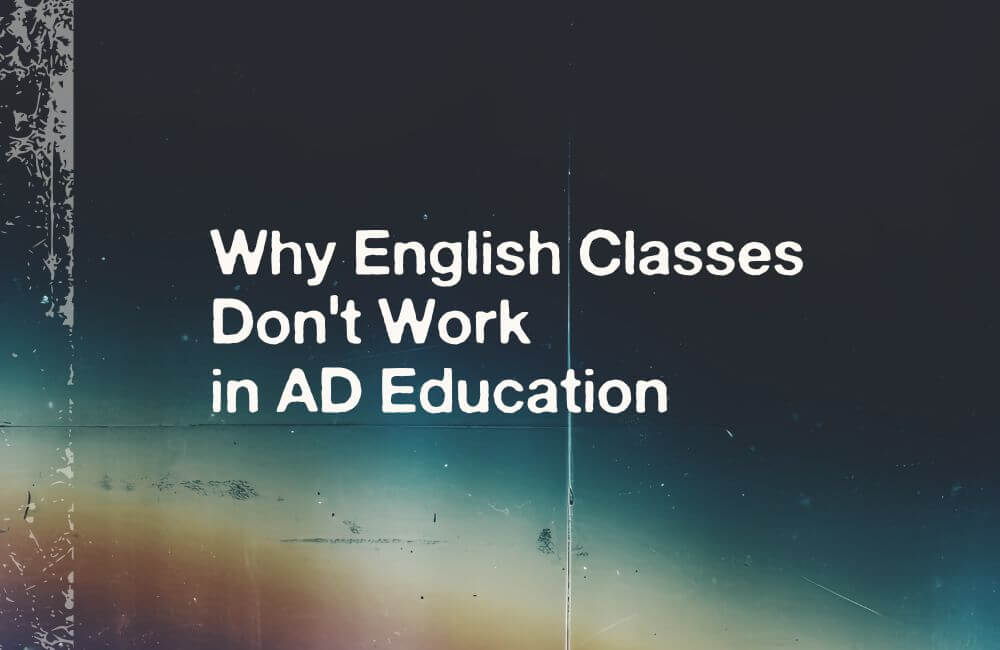English for Art Schools
Are you still giving English lessons?
Or do you train your students in using English for creative careers, in varied professional & semi-professional contexts?
This blog post gives 5 reasons why English classes fail for Art & Design Education.
To learn about our alternative method of developing your students’s English, see our 1% English Method.
01. Large Classes Waste Time
Your Art School English classes don’t work because there’s little point in giving art students English training without supplementing lessons with opportunities to put the language into practice.
But talking in large classes is not a good use of students’ time:
A large group has 3 talking options:
– Presentations, which in a 2-hour class of 20 students = about 4 minutes speaking per student.
– Class discussion, in which only the better 70 per cent of the class contribute, with weaker students staying silent.
– Group work quickly slips into the students’ first language(s) /surreptitious phone checking. again, only the better 70 per cent of the class contribute.
Smaller groups = more talk time, but in a traditional classroom model, smaller groups = more cost to the school.
It’s time to divide resources DIFFERENTLY.
02. ChatGTP
ChatGTP is currently changing how your students will show up in English internationally.
Art Schools educate in a world where AI is setting assignments (the teachers), AI (the students) is completing the assignments, and AI (the teachers) are correcting the assignments.
There’s little point in giving any traditional form of written homework easily completed by AI in seconds.
However, AI skills will enable your students to present CVs, proposals, press releases, write articles and be present on Social Media in English: all the written documents early career artists and designers need.
Written work needs redesigned now, for future abilities.
03. Classrooms
Your compulsory English lessons either frustrate young adults, or make them switch off.
Imagine! All the freedom of self-expression that art school brings: where impulse, investigation and autonomous thought are valued – yet once a week you trap them in a classroom, and force them to learn like high school kids.
Traditional language classes don’t just make students resent English.
It contradicts and dilutes the ethos of an art school, in which the early-career artist develops their identity: as a maker; as creative in the community; in the art world – and internationally.
Language learning should feel like getting your wings ready to fly – not like jumping through arbitrary hoops.
04. Neurodiversity
Your Art School English classes don’t serve equally and it’s time to change that.
Up to 50% of your Art School community (including teachers) would likely self-identify as neurodiverse.
Insisting on English language learning designed for the neurotypical is not only failing to educate up to half your students in English, it will be enforcing the self-belief within neurodiverse learners that they are ‘bad at English’ or ‘hate English’.
This failure of your English tuition won’t be visible to you, but it is eroding confidence and shutting down future opportunities for your students.
Don’t teach the majority. Serve individuals!
“Language learning should feel like getting your wings ready to fly – not like jumping through arbitrary hoops”.
Ruth Pringle, Blue Noun Language Hub
05. Disempowerment
Traditional art school English classes merit ability not progress.
It’s easier to administer tests which show mistakes than create opportunities allowing students’ English skills to grow and flourish.
If you remain locked in an assessment system, you are failing to measure & reward progress.
Can do harder to evaluate.
It’s your institution. Change the rules!
Consider: should English ability even be part of their overall grade?
Consider a simple, fair pass/fail grade instead.
Blue Noun Language Hub
At Blue Noun, we believe that Art Schools shouldn’t have mandatory English classroom lessons.
An art school’s role as an educator across the curriculum is to make students hungry for the information they need: not having it force-fed.
Ill-adapted English Courses Fail in Art and Design Education.
Art & Design English education should help students master what they already know and frame it into skills for their professional future.
It should be so interesting that they show up and work, without having their time forced and controlled.
Good English tuition for the arts hands responsibility onto the learner.
And it empowers.
Above all, it teaches good, autonomous language learning habits for a lifetime.



Recent Comments